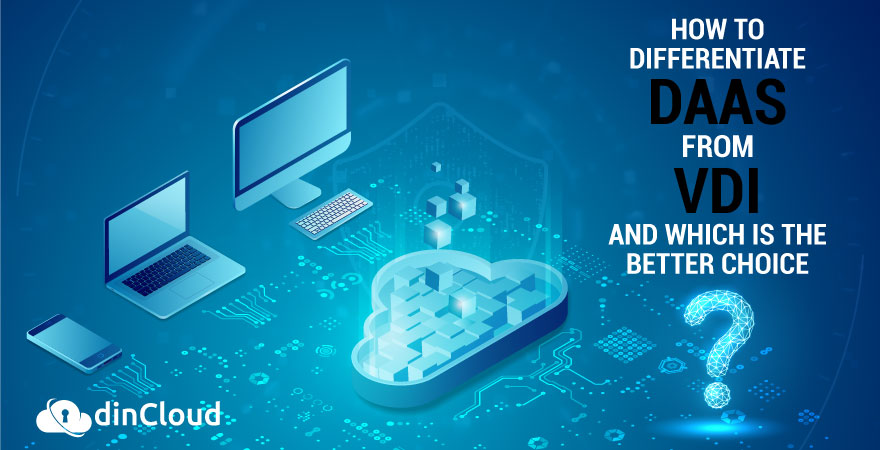Desktop as a Service (DaaS) and Virtual Desktop Infrastructure (VDI) are two mainstream desktop virtualization technologies. Before we dive into the specifics of both and their pros n cons, let’s cover desktop virtualization first.

Intro to Virtualization of Desktops
A virtual desktop exists in the form of an image over a server or a data center. In terms of features, a virtual desktop (VD) will also have a defined storage, CPU, RAM and even a GPU in some graphics intensive use cases.
Also Read: How VDI and DaaS are Supporting Remote Work?
These virtualized computing resources are managed by specialized software and in this way, you get access to a virtual desktop instead of a physical machine. In theory, a virtual desktop allows you access from anywhere and at any time.
What is VDI?
Virtual Desktop Infrastructure or VDI is one way of deploying virtual desktops. In this desktop virtualization model, you create virtualized images of desktop computers over on-premise servers or data center.
In most VDI models, access to virtual desktops is restricted to the secure network of the organization. Although externally accessing a VDI powered solution is not out of question, it increases complexity and enhances security risks.
Also Read: Virtues of VDI and DaaS in Achieving Organizational Efficiency
Introduction to DaaS
Desktop as a Service or DaaS is the other mainstream technology to deploy virtual desktops. In the DaaS model, your virtual machines (VM) or desktops are created over the data centers of a third party Cloud Service Provider (CSP) like dinCloud.
The major factor that differentiates DaaS from VDI is that in case of DaaS, all the underlying hardware is also outsourced to a third party such as dinCloud. This relieves the deploying entity from provisioning and maintaining hardware resources as well.
When it comes to ease of management, DaaS is at a whole new level when compared to VDI. The hardware management bit of VDI tends to undermine the otherwise attractive proposition of deploying virtual desktops.
Why Provision Virtual Desktops?
Now that we have discussed both the major virtual desktop deployment models, let’s briefly touch why we need virtual desktops in the first place.
- Virtualized desktops centralize your IT infrastructure whether it’s DaaS or VDI.
- Managing virtual images of desktops is much easier and efficient for all concerned.
- Updates, patches and software can be managed centrally via DaaS and VDI both.
- You no longer have to access each end point device physically to perform security checks or install upgrades.
- Enterprise data is converged at a central point and no data resides on employee’s end point devices.
- Both DaaS and VDI improve your Business Continuity (BC) posture, as these resources can be accessed remotely.
- With DaaS or VDI, you can better plan Disaster Recovery (DR) as taking regular backups of centralized data is much convenient and practical.
- Employees can access data, processes and applications from anywhere. There is no limitation on the use of endpoint devices and their native operating system (OS).
Also Read: How to Choose Between DaaS and VDI Models?
Use Cases for VDI
A VDI model for virtual desktops would be suited in these conditions:-
- You want data to remain within organizational boundaries.
- Absolute control is required over data and enterprise processes.
- Financial and human resources are not a limiting factor.
- Your IT infrastructure needs are quite predictable.
- Most of your workforce is converged at a few physical locations.
Also Read: How DaaS Outperforms VDI on Many Counts
When to Use DaaS?
The DaaS model of deploying Virtual Desktops will be better in these situations:-
- You can entrust your data to a Cloud Provider (CSP) like dinCloud.
- There is a lack of human and financial resources to manage on premise infrastructure.
- IT infrastructure needs constantly vary with business cycles or seasonality.
- You want to give access to data, processes and apps beyond organizational boundaries.
- There is a sizable workforce in your entity that works remotely.
DaaS v/s VDI – Which is Better
Well, there is no definitive answer to this question. However, we don’t feel hesitation in recommending DaaS over VDI as the former has all the inherent benefits of VDI with one additional trick up its sleeve, which is freedom from managing IT infrastructure.
Also Read: dinCloud among Leaders in the Booming VDI & DaaS Market
By choosing the right Cloud Service Provider (CSP) like dinCloud, you can enjoy unmatched flexibility, security and scalability with its DaaS offering called dinHVD. Contact Us if you have any further questions about our DaaS solutions.


